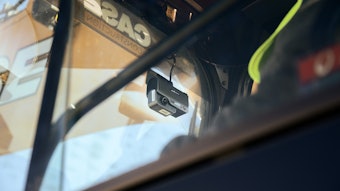Tip 1: Keep Track of Your Service Dates
“We're integrating slowly and trying to do a better job at keeping track,” Ballmann says. “Currently, we're as simple as a little name tag in each machine that has the hours and date of service. So the operator is supposed to notify the mechanic when it's due for service.
“I just had an instance yesterday, my mechanic showed up to an excavator and it was 15 hours over service. And he was all mad. I said, ‘Well, it's on Vision Link. He said ‘I don't have time to look at VisionLink.’ I said, ‘Well, it’s pretty easy. Just tap the Cat app.’ He's got it on his phone and can look at it visually—that is one of the machines. Now all of our machines do not have that feature. But we're working on it. Junior's getting us up to speed and hopefully that we can, we can integrate vision link and some of the pre- Vision-Link equipment.”
“Part of it would be writing the contract. So ever 250 hours, he gets the filters that he's looking for,” says Junior Gilliam of Fabick Cat. “And two, with the Vision Link, it's kind of taking more of the back office approach. We're in the background tracking his machine. So we know when to call them say, ‘Hey, John, you've got a filter order due for your 307 machine. It'll be ready in two days. If you'd like to come get it, you're 50 hours out from your service, it'll be ready for you when it's time to service.”
Tip 2: Use Those Telematics ... They Pay You Back in More Ways Than One
“We're looking for location and hours. I'll sometimes struggle and wonder where we left the last machine, you know, where it was dropped off,” Ballmann says. “And also it's a security aspect. You know, with a location nowadays, you just, you just never know. So there's GPS on it and it adds a little little bit of a safety factor.
“John's already buying filters from Fabick anyway, because he always uses all Cat filters on his Cat machines,” Gilliam says. “But this, like he said, you know, we get him a little bit of a discount on purchasing the filters because it's guaranteeing he's gonna buy them from us. We include his Vision Link subscription in the cost of his contract. So it's just a win-win. It's less invoicing and paperwork for him, and it's guaranteed business for Fabick. We're really striving to be that key strategic partner and with our customers.”
Tip 3: Oil Sampling is Key
“The biggest thing that we do (on the maintenance side) is probably oil sampling,” Ballmann says. “With every service, we collect an oil sample, send it into Fabick, and they send us an email back within 24 hours. You know, it's green, yellow, or red: green meaning no action; yellow, monitor; and red stop what you're doing. Cat knows what metals were used in what components in this oil sampling forecast where we're having excessive wear. So we don't have the catastrophic failures. We haven't really had it much in the heavy equipment side of engines, but the on-highway engines, and they are Cat engines you know, you start seeing metal there. Now, they’re higher miles and things that I bought used. But we haven't seen it so much in the Cat or on the equipment side. It's because (we have) pretty new equipment relatively.”
Tip 4: Change Your Oil Every 250 Hours. Yep.
“(We trialed a) pretty expensive brand (of oil) that really pushed to go to this 500 hour interval,” Ballmann explains. “However, what we started to see is a tooth wear, track wear, tracks out of adjustment, belts, dirty filters. We’re in a dusty environment; all that stuff has to be maintained. Not that we couldn't go do that at 250 hours and not do the oil, but (when) we're at the machine I like to do at all.”
Tip 5: Pay Special Attention to the Undercarriage
“We use an ultrasound to measure the rollers, idlers, track links, trackpads, just to make sure and just kind of forecast to see where Jon's gonna be at,” Gilliam says. “And if it's something we see accelerated, you know, we prep him like, ‘Hey Jon, you're (at) 50% and you've got half the hours that you should have on it. You may want to look at going back with Heavy Duty next time instead of System One or General Duty. And given the pandemic and all the availability issues that's caused, we can utilize Cat’s CPRO program to get parts ordered and you know, 90 days out, so he has them when he's ready for them rather than the machine being down waiting on them.”
















